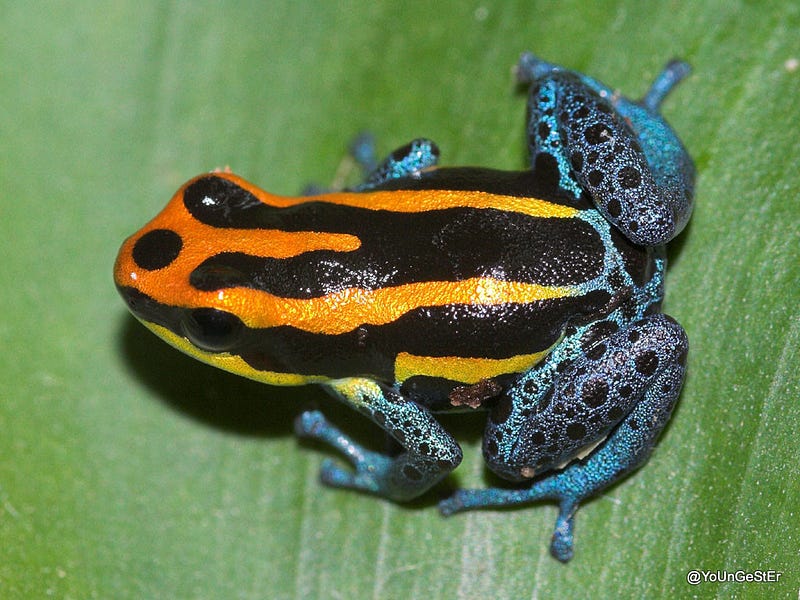# Unveiling the Evolution of Warning Colors in Amphibians
Written on
Chapter 1: Introduction to Aposematism
The vibrant hues of certain amphibians, particularly frogs and salamanders, have long captivated both scientists and nature enthusiasts. Many of these strikingly colorful species possess toxic traits or chemical defenses, using their vivid coloration as a signal to potential predators. This phenomenon, known as aposematism, raises intriguing questions about how these animals developed such conspicuous colors amidst a world filled with vigilant predators.
“The emergence of conspicuous traits in a chemically defended lineage is a complex process,” noted behavioral ecologist Changku Kang from Seoul National University. “Initially, predators lack the ability to associate bright colors with danger, making it difficult for such traits to gain traction in the population.”
Section 1.1: The Research Team's Approach
To delve deeper into this evolutionary enigma, Professor Kang teamed up with Karl Loeffler-Henry from Carleton University and his supervisor, Thomas Sherratt. Loeffler-Henry employs advanced computer simulations to explore how natural selection impacts the coloration of animals.
In their study, the researchers classified over 1,100 species of frogs, salamanders, and newts into five distinct categories based on their color patterns (Figure 1). The classifications ranged from “conspicuous” animals, which exhibit bright reds, yellows, and blues, to “cryptic” species that blend seamlessly into their surroundings. The intermediate groups included fully conspicuous (FV) and partially conspicuous (PV) animals, which exhibit a mix of hidden and visible colors, often employing defensive behaviors to showcase their bright patterns to potential threats.

Subsection 1.1.1: Understanding Coloration Complexity
Dr. Loeffler-Henry emphasized that their approach, utilizing five categories, provides a more nuanced understanding of animal coloration compared to previous studies that typically simplified the classification into just two groups: conspicuous or camouflaged. This differentiation allows for a better grasp of the evolutionary intricacies involved.
Section 1.2: Evolutionary Pathways
To further investigate the evolution of aposematism in amphibians, the researchers examined nine models outlining potential evolutionary paths. These models assessed when species first developed their coloration and toxicity as a means of defense.

Chapter 2: The Evolutionary Journey
Through their research, Professor Kang and Dr. Loeffler-Henry concluded that the development of aposematism follows a defined evolutionary trajectory. Instead of a direct transition from camouflage to bright warning colors, they identified a crucial intermediate phase where a cryptic animal reveals its vivid colors in specific body parts, such as limbs or underbellies, as a warning signal to predators. This display is often triggered by threats, prompting the animal to exhibit hidden bright colors as a form of defense.
Following this, the animal typically develops a chemical deterrent, such as an unpalatable taste or a lethal toxin, leading to the evolution of even more pronounced coloration across its body.
“Aposematism has arisen independently in various amphibian lineages,” Dr. Loeffler-Henry remarked. “The presence of these concealed signals sheds light on the evolutionary mechanisms at play.”
Warning Colors in the Animal World - YouTube
This video explores the vibrant warning colors found in various species, explaining their role in predator deterrence and the evolutionary strategies behind them.
In summary, this study underscores the significance of exploring overlooked evolutionary strategies, enhancing our understanding of how various species develop effective antipredator defenses. The findings also illustrate how the costs associated with being colorful can be mitigated through intermediary evolutionary traits.
Aposematic Coloration - YouTube
This video delves into the concept of aposematic coloration, showcasing examples from nature and discussing how these adaptations benefit species in avoiding predation.
Source:
Karl Loeffler-Henry, Changku Kang, and Thomas N. Sherratt (2023). Evolutionary transitions from camouflage to aposematism: Hidden signals play a pivotal role, Science 379(6637):1136–1140 | doi:10.1126/science.ade5156
Originally published at Forbes.com on 20 March 2023. For more updates, subscribe to my newsletter, typically sent out on the last Friday of each month.